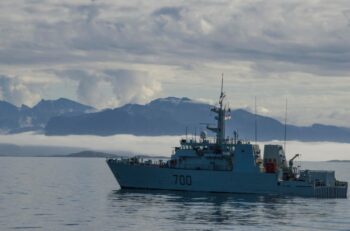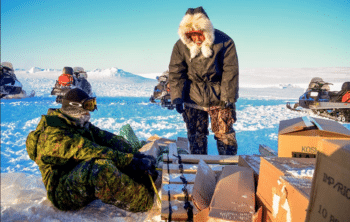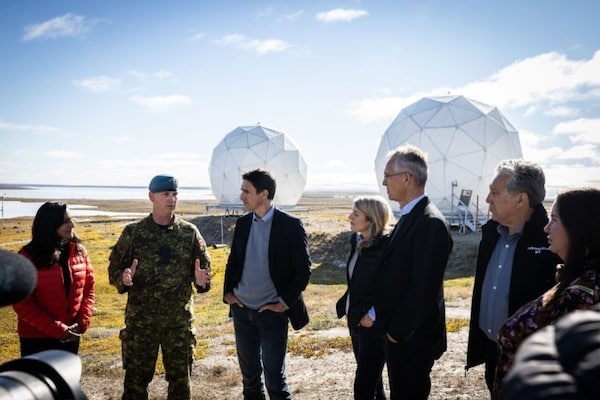Defence Minister Bill Blair and Foreign Affairs Minister Mélanie Joly were recently in Nunavut to promote Canada’s new defence policy update, titled Our North, Strong and Free: A Renewed Vision for Canada’s Defence. The policy change will expand the military presence of the North American Aerospace Defense Command (NORAD) and the North Atlantic Treaty Organization (NATO) in the Arctic. This costly, carbon-intensive plan to militarize the region poses a grave threat both to Inuit communities and to the climate.
NORAD Modernization
As Our North, Strong and Free explains, the federal government will invest $38.6 billion over 20 years to modernize NORAD, the continental defence partnership established in 1958 between Canada and the United States. For this modernization, the government will purchase new weapons systems and build new military infrastructure across the northern territories and Labrador. Canada will establish forward operating bases in Inuvik, Yellowknife, Iqaluit, and Goose Bay, with a permanent presence of Canadian and American soldiers at each base.
New integrated radar and missile systems, surveillance platforms, maritime sensors, and cyber operations will also be installed. The federal government will construct or expand runways, hangars, and roads for military vehicles and aircraft, and to move fuel, supplies, and munitions for the Department of National Defence (DND). Although Blair and Joly have stated that this infrastructure will be dual-use (military and civilian), the priority will be meeting the requirements of the U.S. Department of Defense.
The Canadian government has signed contracts for 140 new, American-made tactical aircraft including F-35 fighter jets, P-8A Poseidon anti-submarine aircraft, attack helicopters, and MQ-9 Reaper armed drones as well as CC-330 strategic tanker aircraft. The government will also spend $60 billion on new diesel-powered surface combatant warships and is exploring procurement of submarines. These fossil fuel-powered aircraft and naval vessels will train and be stationed in the North, releasing excessive carbon emissions. The transport and use of petroleum products by the military risks toxic contamination and will exacerbate the climate crisis.
NATO and Canadian Armed Forces exercises in the North
In the summer of 2022, after the Canadian government formally announced that it would upgrade NORAD, Prime Minister Trudeau welcomed NATO Secretary General Jens Stoltenberg to Nunavut. It was the first time that a NATO secretary general has visited Canada’s Arctic. Trudeau and Stoltenberg toured one of the sites of the North Warning System (NWS) and visited Wing 4 in Cold Lake, Alberta, to see Canada’s largest and busiest air force base, which is to host the F-35 fleet. Stoltenberg said that his visit showed the strategic importance of Canada’s northern territories for the Euro-Atlantic alliance.
NATO allies are increasing their training tempo in the North. This year, 90,000 allied military personnel took part in Steadfast Defender, NATO’s biggest exercise since the Cold War, from January to May. This number included more than a thousand Canadian Armed Forces sailors, soldiers, aviators, and special forces members. The exercise was a simulation of a NATO Article 5 response to an attack. The first phase focused on rapid deployment and combat in the North Atlantic, the Arctic, and the Baltic Sea. The Steadfast Defender exercise was dangerously provocative toward Russia and yielded adverse climate and environmental impacts.
Earlier this year, the CBC reported that Germany had asked Canada for permission to resume low-level fighter jet training at CFB Goose Bay, in Labrador. Germany has purchased a new fleet of F-35s, which are extremely loud, making it more difficult to train in Europe. From the 1980s through the 1990s, the German Air Force and other NATO allies conducted fighter jet training over Innu territory in Labrador, despite the persistent resistance of the Indigenous people. The Labrador Innu blockaded the runways and were arrested and imprisoned. Grand Chief Simon Pokue of the Innu Nation recalled this history in a recent letter to the Defence Minister to convey his people’s opposition to any resumption of NATO low-level fighter jet training over their territory. Nonetheless, Canada’s new fleet of F-35s, expected to arrive in 2026, together with American F-35s, are expected to train and fly over Indigenous territory in the North.
The Canadian Armed Forces regularly conduct military exercises in the North as part of Operation NANOOK. Operation NANOOK began in 2007, at which time it featured only a single major military activity. Since 2018, however, it has been broadened and separated into four exercises held throughout the year in different northern communities, with participation from the United States, Belgium, Denmark, France, Germany, and other NATO members. Trudeau has described Canada’s Arctic as NATO’s northern and western flanks. Canadian Chief Warrant Officer Terence Wolaniuk described the military’s plans in the Arctic in an interview: “The idea is to train for war and be prepared to fight war.” Former U.S. Secretary of State Mike Pompeo called the Arctic “an arena for power and for competition” over natural resources and sea routes.
Militarization harms Inuit communities

HMCS Kingston sails past the mountainous coast of Greenland during Operation NANOOK. (Photo: LS Houston-Goudge/Department of National Defence)
Yet, for the Indigenous people of the Arctic, the Inuit, their territory is not a theatre of war. Their ancestral homeland, which they call Inuit Nunangat, encompasses not only the land but also the water and the ice. Inuit Nunangat represents 40 percent of Canada’s land area and more than 70 percent of its coastline. The Indigenous people, who comprise half of Canada’s Arctic population of 200,000 people, live in 51 communities spread out across the region. They want Inuit Nunangat to be protected, not militarized.
The federal government claims that NORAD and NATO will ensure Canadian “sovereignty” in the Arctic. Yet, NORAD, which is dominated by the United States and has its headquarters in Colorado Springs, and NATO, also led by the U.S. with headquarters in Brussels, gives Washington disproportionate control over Canada’s Arctic and threatens Inuit sovereignty. In 2009, Inuit leaders from Greenland, Canada, Alaska, and Russia launched a Circumpolar Inuit Declaration on Sovereignty in the Arctic, which affirmed their rights to self-determination. This sovereignty declaration has been subsequently asserted many times. The Canadian government’s plan to militarize the northern territories will, as in the past, undermine this Inuit declaration of sovereignty along with their land claim agreements.
During the Cold War in the 1950s, the United States and Canada constructed three early warning radar lines across the North American continent to detect nuclear missile strikes from the Soviet Union. Many of these sites were structured as military bases and manned by American and Canadian air force personnel. There was the Distant Early Warning (DEW) Line of 63 radar sites, situated approximately along the 70th parallel from northwestern Alaska to Iceland. Forty-two of these radar sites were located across 3,500 kilometres of the Canadian Arctic, yet flew the American flag. Below the DEW Line, along the 55th parallel, was the Mid-Canada Radar Line (MCRL), also known as the McGill Fence, with eight manned and 90 unmanned stations stretching from Dawson Creek, British Columbia, to Hopedale, Labrador. The Canadian government funded and built the MCRL. Further below, spanning the 50th parallel, was the Pine Tree Line, with 34 radar stations reaching from Vancouver Island to Newfoundland. Although these three radar lines crossed Indigenous lands, Indigenous peoples were not consulted and had no control over these sites. In the late 1980s, Canada and the U.S. abandoned most of these radar lines, including their buildings, fuel tanks, barrels containing degreasers and antifreeze, batteries, vehicles, and garbage dumps, simply leaving them to decay and contaminate the surrounding land and water. It took years and hundreds of millions of dollars to clean up these radar sites. Now, they are to be re-militarized and will again pose risks to Indigenous communities.
To stake its claims to sovereignty during the Cold War, the Canadian government deceived and forcibly relocated 92 Inuit to remote islands in the High Arctic. These relocations caused painful separations among Inuit families as well as lasting trauma that was documented in the 1996 Royal Commission on Aboriginal Peoples. In addition, the final report of the 2014 Qikiqtani Truth Commission described the long-term pernicious impacts of colonial practices on Inuit people in the North. These commissions revealed that the federal government failed to consult the Inuit on policies and decisions that related to their territory, and neglected of the needs of Indigenous communities for decades.
It was not until 2019 that the federal government consulted with Indigenous peoples and stakeholders, and co-developed with them a new Arctic and Northern Policy Framework. This framework is a comprehensive plan on the part of the federal government to improve the well-being of Indigenous people, ensure the sustainable development of their natural resources, and take action on the climate crisis and protect the environment. During the consultations, Inuit participants advocated for health care, education, safe housing, food security, and the preservation of Indigenous language and culture.
Yet, in an annual report released last year, federal housing advocate Marie-Josée Houle explained that the majority of Inuit people are still living in overcrowded, unsafe housing. As well, many Indigenous people lack adequate water and sanitation as well as access to reliable heat and energy for their homes. As Houle emphasized, “the level of distress cannot be understated.” The federal government’s new defence plan update will compound this distress by diverting public resources away from social programs to military projects, impeding the implementation of the 2019 Framework and causing environmental harm to Inuit Nunangat.
Militarization exacerbates climate change and biodiversity loss
In their joint press conference in Nunavut, Blair and Joly did not once acknowledge the climate and environmental impacts of Canada’s NORAD modernization and NATO operations in the Arctic. They mentioned only that this polar region is warming four times faster than other areas in Canada. Two scientific reports, published in the journals Nature and Geophysical Research Letters, confirm that the Arctic, an extremely vulnerable oceanic ecosystem, is indeed warming four times faster than anywhere else on the planet.
According to the Polar Regions chapter in the Intergovernmental Panel on Climate Change’s Sixth Assessment Report published last year, the Arctic is a crucial part of the cryosphere, the frozen area of the Earth and plays an important role in regulating the global climate system, but today the region is rapidly warming and experiencing sea level rise and coastal erosion. The IPCC report warned that climate change was causing severe impacts in the North, such as more intense fires and flooding. Last year, the city of Yellowknife was evacuated because of a massive, out-of-control wildfire.
As the permafrost melts and the ocean acidifies, Arctic wildlife is increasingly under threat. The Species at Risk: Nunavut report shows that due to climate change there are more endangered species than before, including caribou, polar bears, fish, seals, and whales. The deployment of military aircraft and naval vessels to the region for NORAD and NATO means more noise, more invasive species, and more environmental damage, compounding the harm to at-risk species. The loss of biodiversity in the North negatively impacts the Inuit people’s hunting and gathering practices and food security. These environmental risks are not mentioned in the defence policy update.
In speeches and interviews that Defence Minister Blair has given since the release of the new policy update, not once has he mentioned the military’s impacts on Inuit communities or the climate. Blair has stated only that climate change is making the Arctic Ocean more accessible to Russia and China—the dual threat that purportedly justifies Canada’s militarization of the North. Yet, Russian President Putin and Chinese President Xi have issued several public statements expressing their desire for peace and cooperation with the West. China has even offered to help build civilian infrastructure for Indigenous communities in the Canadian territories that have been neglected by the federal government. Moreover, the Inuit themselves have called for peace and opposed the militarization of the Arctic.
Renew the calls to make the Arctic a zone of peace and cooperation

Members of 1st Canadian Ranger Patrol Group, deployed with the Arctic Response Company Group, prepare their qamutiiks before departing for a patrol in Resolute, Nunavut during Operation NUNALIVUT, March 8, 2018. (Photo: Petty Officer Second Class Belinda Groves/Department of National Defence)
For four decades, Canada’s Inuit have cooperated and engaged in peacebuilding with the Indigenous peoples of the other Arctic nations through the Inuit Circumpolar Council (ICC) and the Arctic Council. The ICC is a non-governmental organization founded in 1977. It represents approximately 180,000 Inuit in Canada, Alaska, Greenland, and Russia, and has consultative status at the United Nations. In 1989, Mary Simon, then ICC president, published an important article titled “Toward an Arctic Zone of Peace: An Inuit Perspective” in the Canadian journal Peace Research. As Simon presciently warned:
Any excessive military build-up in the North only serves to divide the Arctic, perpetuate East-West tensions and the arms race, and put our people on opposing sides. For these and other reasons, Arctic militarization is not in the interests of the Inuit in Canada, the Soviet Union [Russia], Alaska and Greenland. Nor do such military preparations further security or world peace.
She proposed steps that Arctic states should take to designate the region a zone of peace and a nuclear-weapons-free zone (NWFZ). In her article, Simon also wrote: “As a general rule, the safeguarding of the Arctic environment must take precedence over military exercises and activities.” Simon is now the Governor General of Canada. Her appeal to make the Arctic a zone of peace and a NWFZ ought to be renewed as the climate crisis deepens and international conflicts escalate.
In the 2018 Utqiaġvik Declaration and the 2019 Arctic and Northern Policy Framework, the Inuit have been explicit in their calls for peace and cooperation. The Framework states:
There were some consistent key messages on international issues raised by participants from all regions. They included a desire to maintain the circumpolar Arctic as a region of peace and cooperation through efforts to strengthen the international rules and institutions that govern the Arctic. Preserving the role of the Arctic Council as the leading forum for circumpolar cooperation was singled out as a priority by many participants.
Canada was instrumental in establishing the Arctic Council in 1996. The Council is an intergovernmental forum consisting of eight permanent member states: Canada, Denmark (representing Greenland), Finland, Iceland, Norway, Russia, Sweden, and the United States. It also includes 13 non-member states and six permanent Indigenous members. The Council’s mandate is to promote cooperation and sustainable development above the Arctic Circle. Significant scientific research has been carried out, and social and environmental programs have been developed collaboratively by the Council.
The chair of the Arctic Council rotates among its permanent members. In February 2022, Russia was the chair, but after its invasion of Ukraine—for which, notably, NATO also bears responsibility—the other seven permanent members boycotted meetings of the Council. Yet, instead of supporting negotiations to end the war, Canada and the other six permanent members of the Arctic Council (other than Russia) are all NATO members and are sending weapons to Ukraine to prolong the war and “weaken Russia,” as Minister Joly has declared. The Trudeau government is also using the war in Ukraine as a justification for increasing the defence budget and militarizing the North.
The government’s warlike stance contradicts the Inuit approach. As the Inuit Circumpolar Council reminded the Arctic Council in a March 7, 2022 public statement:
Inuit are committed to the Arctic remaining a zone of peace, a phrase coined by former USSR President Mikhail Gorbachev in a 1987 speech in Murmansk. ICC has repeatedly echoed this message in all of its guiding documents, most recently in the Utqiaġvik Declaration of 2018 in which it was mandated to lay the groundwork to declare the Arctic as a peaceful Zone.
The current President of the ICC, Lisa Qiluqqi Koperqualuk, reiterated the Inuit’s right to peace and the priority for their homeland to be a zone of peace in her briefing to the Senate study on the Arctic in November, 2022. She emphasized the ICC’s values of disarmament, non-violent resolutions of conflicts and international cooperation, including with Russia. Shamefully, the subsequent report on the Arctic by the Standing Senate Committee on National Security, Defence and Veterans Affairs and the report by the House of Commons Standing Committee on National Defence ignored the ICC’s recommendations.
To protect Indigenous communities and the circumpolar cryosphere, conflicts among the Arctic states must be resolved with diplomacy and international law, not weapons and warplanes. The Canadian government must work cooperatively with all Arctic Council members and adhere to the United Nations Convention on the Law of the Sea and the Commission on the Limits of the Continental Shelf. Most crucially, the federal government must respect the Inuit declaration of sovereignty and their demand for peace, cooperation, and sustainable development in the Arctic. The Trudeau government must cancel its plans to militarize the North for NORAD and NATO, because the risks to the Inuit and the climate are too great.
Tamara Lorincz is a PhD candidate at the Balsillie School of International Affairs, Wilfrid Laurier University, and a fellow with the Canadian Foreign Policy Institute.

